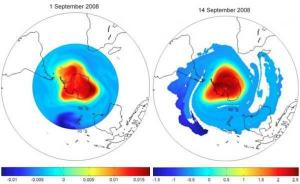 Geophysical phenomena such as the dynamics of the atmosphere and ocean circulation are typically modeled mathematically by tracking the motion of air or water particles. These mathematical models define velocity fields that, given (i) a position in three-dimensional space and (ii) a time instant, provide a speed and direction for a particle at that position and time instant.
Geophysical phenomena such as the dynamics of the atmosphere and ocean circulation are typically modeled mathematically by tracking the motion of air or water particles. These mathematical models define velocity fields that, given (i) a position in three-dimensional space and (ii) a time instant, provide a speed and direction for a particle at that position and time instant.
"Geophysical phenomena are still not fully understood, especially in turbulent regimes," explains Gary Froyland at the School of Mathematics and Statistics and the Australian Research Council Centre of Excellence for Mathematics and Statistics of Complex Systems (MASCOS) at the University of New South Wales in Australia.
"Nevertheless, it is very important that scientists can quantify the 'transport' properties of these geophysical systems: Put very simply, how does a packet of air or water get from A to B, and how large are these packets? An example of one of these packets is the Antarctic polar vortex, a rotating mass of air in the stratosphere above Antarctica that traps chemicals such as ozone and chlorofluorocarbons (CFCs), exacerbating the effect of the CFCs on the ozone hole," Froyland says.
In the American Institute of Physics' journal Chaos, Froyland and his research team, including colleague Adam Monahan from the School of Earth and Ocean Sciences at the University of Victoria in Canada, describe how they developed the first direct approach for identifying these packets, called "coherent sets" due to their nondispersive properties.
This technique is based on so-called "transfer operators," which represent a complete description of the ensemble evolution of the fluid. The transfer operator approach is very simple to implement, they say, requiring only singular vector computations of a matrix of transitions induced by the dynamics.
When tested using European Centre for Medium Range Weather Forecasting (ECMWF) data, they found that their new methodology was significantly better than existing technologies for identifying the location and transport properties of the vortex.
The transport operator methodology has myriad applications in atmospheric science and physical oceanography to discover the main transport pathways in the atmosphere and oceans, and to quantify the transport. "As atmosphere-ocean models continue to increase in resolution with improved computing power, the analysis and understanding of these models with techniques such as transfer operators must be undertaken beyond pure simulation," says Froyland.
Their next application will be the Agulhas rings off the South African coast, because the rings are responsible for a significant amount of transport of warm water and salt between the Indian and Atlantic Oceans.

 Previous page
Previous page Back to top
Back to top







